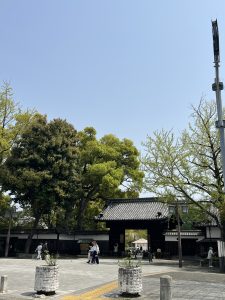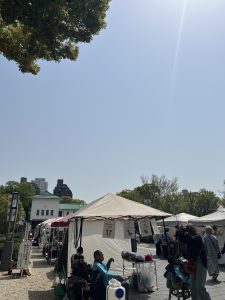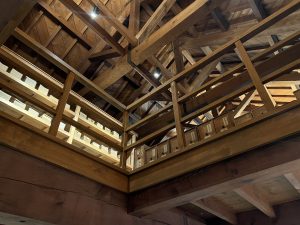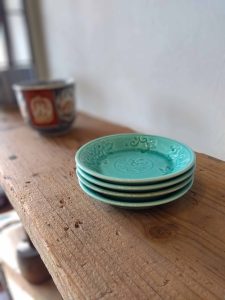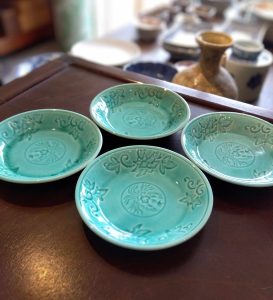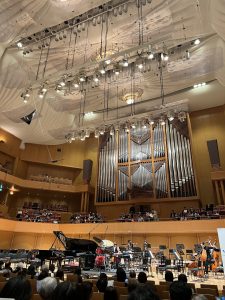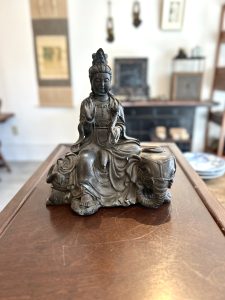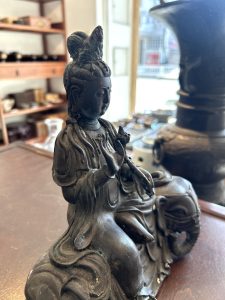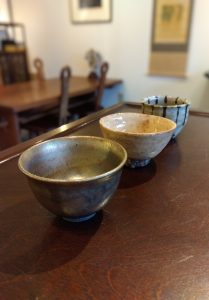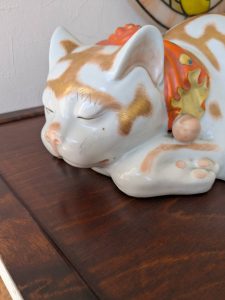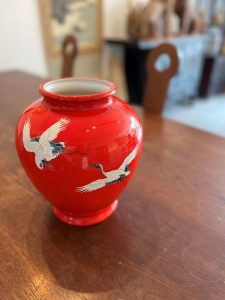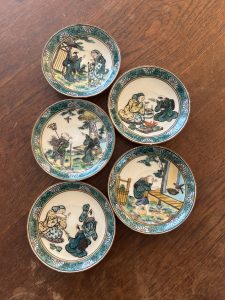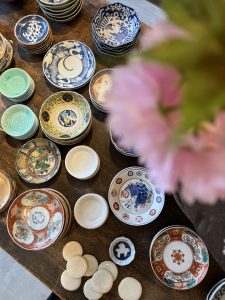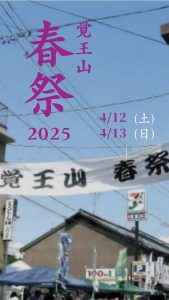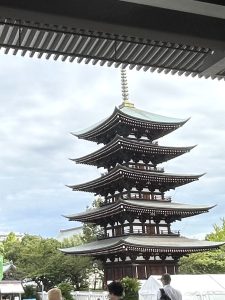関西万博の情報が溢れてきましたね(愛知県名古屋市千種区姫池通 骨董買取 古美術風光舎)
2025.04.20
関西万博が開幕して一週間が過ぎ、訪れた人からの様々な情報がSNSなどでも取り上げられていますね。
私は1回くらい行ければいいかな、くらいの熱量でしたのであまり調べておらず…。ただ何年も前から楽しみにし、絶対に行きたいという家族がおりまして、ネットの情報を得るすべも分からず一人で会場に突撃する勢いでしたので、さすがに私も調べ始めました。
万博に興味のある方はご存知のことばかりかもしれませんが、よろしければお付き合いください。
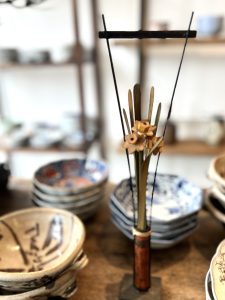
まずチケットの購入方法は大きく2種類あり、
1つ目はパソコンやスマホから「大阪・関西万博」のホームページにアクセスして「万博ID」を取得しチケットを購入、その後行きたい日時が決まれば来場日時を入力して予約をとります。
2つ目は旅行会社やコンビニで「引換券」を購入し、当日に入場ゲート前の案内所で「QRコード付きの当日チケット」と引き換えます。
コンビニだと便利だと思いがちですが、コンビニの端末操作が必要になります。私は結構苦手でいつも店員さんの手を煩わせています。コンビニの引換券には2種類あり「日時指定引換券」と日時を指定しない「予約引換券」です。
日時を指定しない場合は、予約必須日(4/26~5/7、6/1~8/8の土日祝日、8/9~31、9/13~10/13)は入場できず、それ以外の日は11時以降なら入場できますが、確実ではなく、混雑状況によっては入れないこともあるそうです。
旅行代理店では、日時を指定しない「予約可能引換券」と「日時指定付きチケット」があり、この「日時指定付きチケット」には既にQRコードも付いており、そのまま入場できるため、ゲート案内書で引き換える手間が省けます。なんといっても旅行代理店の窓口で対面で購入できるのが年配の方には助かるのではないでしょうか。
また入場ゲート前でも当日チケットは購入できるようですが、販売数に限りがあるため、来場日によっては購入できなかったり、長時間並ぶこともあるようなので、やはりコンビニか旅行代理店で購入しておく方が安心だそうです。
チケット購入だけでも複雑なのですが、更にどうしても行きたいパビリオンやイベントがある人のための、「パビリオン事前予約」の方法が3種類あります。
1つ目が、来場3か月前~2か月前に申し込む「2か月前抽選」、2つ目が来場1カ月前~8日前に申し込む「7日前抽選」、3つ目は来場3日前~前日に申し込む「空き枠申込」です。
「2か月前抽選」と「7日前抽選」はそれぞれ第1希望から第5希望まで申し込むことができ、抽選で当選するのは5つのうち1つのみです。そして全て落ちる可能性もあります。どうしても行きたいパビリオンやイベントがあれば第1希望から第5希望まで全て同じものに申し込むことが出来ますが、人気が高いと全て落ちる可能性も高くなります。また「2か月前抽選」のほうが当選枠が多くなっているそうなので、来場まで余裕のある人は早めに申し込んだ方がよさそうです。
当選した人には当選メールが届きますが、落選した人にはメールが来ないのでマイページにログインして確認する必要があるそうです。
しかし全落ちしても希望はあります。「2か月前抽選」と「7日前抽選」で落選したとしても、キャンセルが出て直前の「空き枠申込」で入れる場合もあるそうです。ただこの「空き枠申込」の来場3日前からというのは「来場3日前の午前0時」に始まるそうなので注意が必要です。夜の0時をまわると一斉に申し込みが始まり、ネットが繋がりにくくなることもあるのだとか。
更に会場に入場してから10分後から当日予約も可能となります。ここでも注意が必要で、当日予約は1枠ずつしか予約できず、予約した1枠を退場してからしか次の予約はとれません。なので遅い時間で予約すると、その時間になるまでのパビリオンなどは予約できないため早めの時間からとっていく方がいいかもしれません。
コンビニや旅行会社で購入したチケット会場内に設置された端末から予約できるようです。
と色々書きましたが、予約の必要のない海外パビリオンもたくさんあり、雰囲気を味わうだけでも十分楽しめると思います。ただ会場がかなり広くてユニバーサルスタジオの3倍の広さがあるので、歩きやすい靴で行くのは必須です。
アクセスの方法は、電車、バス、車で行くことが出来ますが、車は駐車代が4000円から7500円で、尼崎や堺などになることもあるそうで、少し離れた駅近くパーキングに停めるという荒業を勧めるている人もいます。シャトルバスは予約が必要なので、面倒な方はやはり電車でしょうか。あとキャリーバックは預かり金が1万円だそうですのでご注意ください。
家族のために調べておりましたが、すっかり私がとりこになりました。
イタリア館の古代ローマ彫刻「ファルネーゼのアトラス」はアジアで初めて展示され、高さ2メートル、高さ2トンの作品が飛行機で運ばれてきたとか。チェコ館のピルスナービールも飲んでみたい!チェコ館の屋上は水上ショーも見える穴場だそうです。他にも色々書きたかったのですがチケットの取り方だけで長文になってしまいましたのでこの辺で。
それでは、また次の機会に。(スタッフH)
A week has passed since the Kansai Expo opened, and various information from those who visited the Expo has been featured on social networking sites.
I had not done much research on the Expo, as I was only excited enough to go at least once…. However, I had a family member who had been looking forward to the Expo for years and wanted to go, and he was determined to go to the venue by himself without knowing how to get information from the Internet, so I started to do my own research.
Those of you who are interested in the Expo may already know this, but if you don’t, please bear with me.
There are two main ways to purchase tickets.
The first is to access the Osaka-Kansai Expo website from a computer or smartphone, obtain an “Expo ID,” purchase a ticket, and then make a reservation by entering the date and time of your visit if you have decided when you would like to go.
The second is to purchase an exchange ticket at a travel agency or convenience store, and exchange it for a ticket with a QR code at the information desk in front of the entrance gate on the day of the event.
You may think it is more convenient at a convenience store, but you will need to operate the terminal at the convenience store. I am not very good at this, and I always have to bother the clerk. There are two types of vouchers at convenience stores: “date/time-specified vouchers” and “reservation vouchers” that do not specify a date/time.
If you do not specify the date and time, you cannot enter on days when reservations are required (4/26-5/7, Saturdays, Sundays, and holidays from 6/1-8/8, 8/9-31, and 9/13-10/13), and on other days you can enter after 11:00, but it is not guaranteed and depending on the crowds, you may not be allowed in.
At travel agencies, there are “reservable exchange tickets” and “tickets with date and time” that do not specify the date and time. These “tickets with date and time” already include a QR code and allow you to enter directly, saving you the trouble of having to redeem the ticket at the gate information sheet. The best part is that it is possible to purchase tickets in person at the travel agency counter, which may be helpful for the elderly.
It is also possible to purchase tickets on the day of the event in front of the entrance gate, but since the number of tickets sold is limited, it may not be possible to purchase tickets on certain days or there may be long lines, so it is safer to purchase tickets at a convenience store or travel agency.
In addition to the complicated process of purchasing tickets, there are three ways to make “pavilion advance reservations” for those who have pavilions or events that they really want to visit.
The first is the “2-Month Advance Lottery,” which is applied for 3 to 2 months prior to the visit, the second is the “7-Day Advance Lottery,” which is applied for 1 to 8 days prior to the visit, and the third is the “Open Space Application,” which is applied for 3 days prior to the visit to the day before.
In the “2 months prior to the lottery” and “7 days prior to the lottery,” you can apply for your first to fifth choices, and only one of the five choices will be selected in the lottery. And there is a possibility that all of them will fail. If there is a pavilion or event that you really want to visit, you can apply for the same pavilion or event from your first to fifth choice, but if it is very popular, there is a high possibility that you will fail in all of them. Also, it is said that the “2-month advance lottery” has more winning slots, so it is better to apply early if you have enough time before your visit.
Winners will receive an e-mail for those who have been selected, but those who have not been selected will not receive an e-mail, so they will need to log in to My Page to confirm their selection.
However, there is still hope even if you fail the lottery. Even if you were not selected in the “2 months before lottery” and “7 days before lottery,” you may still be able to apply for a “vacant slot” at the last minute due to a cancellation. However, please note that the “open slot application” starts at “midnight three days prior to the visit”. After midnight, all the applications start coming in at once, and it is sometimes difficult to connect to the Internet.
Furthermore, reservations can be made on the day of the event from 10 minutes after entering the venue. Again, be aware that same-day reservations can only be made for one slot at a time, and the next reservation can only be made after you have left one slot you have reserved. Therefore, if you make a reservation late in the day, you will not be able to make a reservation at the pavilion until that time, so it may be better to make a reservation early in the day.
As I mentioned above, there are many overseas pavilions that do not require reservations, and I think you will be able to enjoy the show just to get a feel for the atmosphere. However, the venue is quite large, three times the size of Universal Studios, so it is essential to wear shoes that are comfortable for walking.
You can get there by train, bus, or car, but parking fees for cars range from 4,000 yen to 7,500 yen, and some people recommend parking at a parking lot near the station, which is a little further away. Some people recommend parking near a station a short distance away. Shuttle buses require reservations, so if this is too much trouble for you, you may want to take the train. Also, please note that there is a 10,000 yen deposit for carry-on bags.
I was looking into this museum for my family, but now I am completely hooked.
The “Atlas of Farnese,” an ancient Roman sculpture in the Italian Pavilion, was exhibited for the first time in Asia, and the 2-meter-high, 2-ton piece was brought in by airplane. I would also like to try the Czech Pavilion’s Pilsener beer! I heard that the rooftop of the Czech Pavilion is a hole-in-the-wall where you can also see the water show. There is too much information to write about, so I’ll leave it at that.
I hope to see you again next time. (Staff H)
*****************
ご実家の整理やお片付けなどをされている方のご相談などが多くございます。
お片付けなどくれぐれもご無理のないようになさってくださいませ。
風光舎では古美術品や骨董品の他にも絵画や宝石、趣味のお品など様々なジャンルのものを買受しております。
お片付けをされていて、こういうものでもいいのかしらと迷われているものでも、どうぞお気軽にご相談下さいませ。
また風光舎は、出張買取も強化しております。ご近所はもちろん、愛知県内、岐阜県、三重県その他の県へも出張いたします。
まずは、お電話お待ちしております。
なお、毎月21日の持込鑑定会では無料鑑定・買取・持込など、ご予約なしで承っております。
ご近所の皆さま、ご遠方のみなさまも、お気軽にお越しくださいませ。
愛知県名古屋市千種区姫池通
骨董 買取【古美術 風光舎 名古屋店】
TEL052(734)8444
10:00-18:00 OPEN
#出張買取#骨董#古美術#骨董品#絵画#版画#茶道具#刀剣#彫刻

